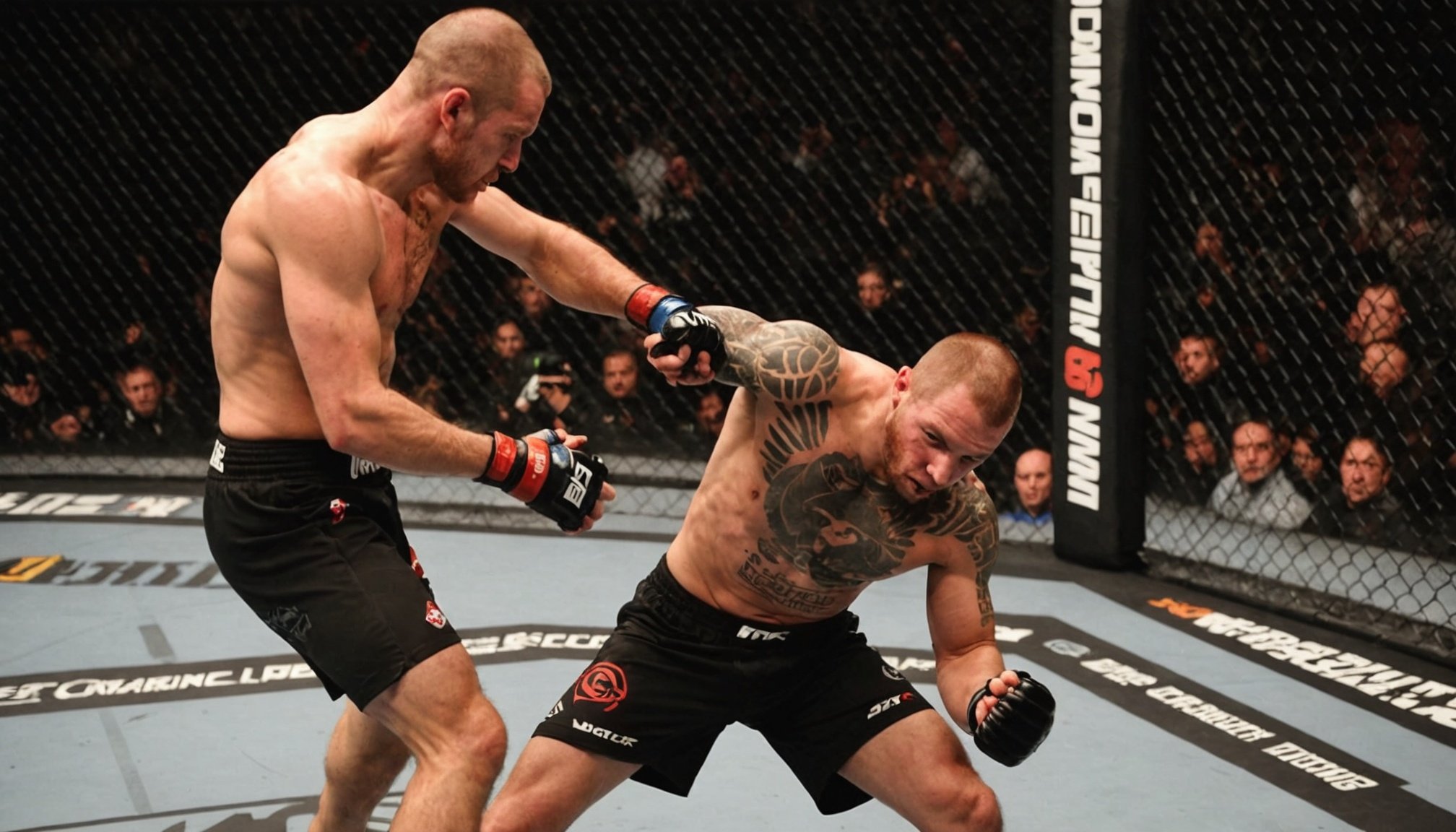Mastering Cage Control: Effective Strategies for UK MMA Fighters to Enhance Their Technique
In the dynamic and physically demanding world of Mixed Martial Arts (MMA), mastering cage control is a crucial aspect that can significantly impact a fighter’s performance and outcome in the cage. For UK MMA fighters, understanding and perfecting these strategies can be the difference between victory and defeat. Here, we delve into the essential techniques, training methods, and strategic approaches that can enhance a fighter’s cage control.
Understanding the Importance of Cage Control
Cage control in MMA is more than just physical dominance; it’s a blend of technique, strategy, and mental toughness. It involves controlling the positioning and movement within the cage to create favorable opportunities for strikes, takedowns, and submissions.
Topic to read : Preserving Cultural Heritage: Strategies for UK Traditional Wrestlers in Training
“Pummeling is a core technique that allows you to achieve just that,” explains an MMA coach. “It’s about gaining positional control over your opponent, particularly in the clinch, which can make all the difference in a fight”[2].
Pummeling: The Key to Clinch Dominance
Pummeling is a fundamental grappling technique in MMA that involves the continuous exchange of underhooks between you and your opponent. Here’s a detailed breakdown of the four-step pummeling sequence:
This might interest you : Ultimate Guide to Mental and Physical Prep for Competing in UK National Judo Championships
The Four-Step Pummeling Sequence
- Inside Position:
- Start in the neutral clinch position with both you and your training partner standing chest-to-chest.
- Secure the “inside position” by getting your arms under your opponent’s arms, specifically by obtaining double underhooks and then securing a body lock around their torso.
- This position gives you optimal control in clinch standing positions, making it easier to trip or takedown your opponents[2].
- Switch Sides:
- Once you secure underhooks, it’s your training partner’s turn to secure double underhooks on you.
- This continuous exchange is what pummeling is all about, keeping the fight dynamic and challenging for both parties[2].
- Regain Inside Position:
- Work to regain the inside position by pummeling your opposite arm back inside.
- Aim to secure double underhooks on the other side, mirroring your initial position[2].
- Repeat:
- The pummeling sequence is continuous and dynamic. As your opponent attempts to regain inside control, you’ll switch sides and work to maintain dominant positioning in the clinch[2].
Key Pummeling Techniques
To master pummeling, several key techniques must be practiced and perfected:
- Head Position: Maintain proper head positioning by keeping your forehead on your opponent’s chest or face. This helps control their posture and makes it challenging for them to land effective strikes[2].
- Hand Placement: Focus on placing your hands deep, gripping your opponent’s back or sides. Ensure you lock your arms together once you’ve successfully secured underhooks[2].
- Hip Movement: Your hip movement is crucial during pummeling. Stay mobile and use your hips to create angles and maintain balance[2].
- Level Changes: Vary the levels of your pummeling to keep your opponent guessing. Drop your hips lower or raise them higher to disrupt their balance[2].
- Pressure And Forward Movement: Apply forward pressure, forcing your opponent to react to your movements. This keeps them on the back foot and limits their offensive opportunities[2].
The Role of Strength Training in Cage Control
Strength training is an integral part of any MMA fighter’s regimen, and it plays a significant role in enhancing cage control. Here are some key aspects to focus on:
Functional Strength
- Upper Body Strength: Developing strong shoulders, back, and arms is crucial for maintaining control in the clinch. Exercises like pull-ups, rows, and shoulder presses are essential[2].
- Core Strength: A strong core stabilizes your body and helps in maintaining balance during pummeling and other grappling techniques. Incorporate exercises like planks, Russian twists, and leg raises into your routine.
- Lower Body Strength: Strong legs and hips are vital for generating power and maintaining balance. Squats, deadlifts, and lunges are must-haves in any MMA strength training program.
Conditioning
- Cardiovascular Endurance: MMA fights are highly intense and require sustained energy levels. Incorporate high-intensity interval training (HIIT) and cardio exercises like running, swimming, or cycling to improve your endurance.
- Muscular Endurance: This is critical for maintaining performance over the duration of the fight. Focus on exercises that work multiple muscle groups at once and incorporate circuit training into your routine.
Integrating Striking Techniques with Cage Control
While grappling techniques like pummeling are essential, striking is also a vital component of MMA. Here’s how you can integrate striking techniques with your cage control:
Setting Up Strikes from the Clinch
- Use pummeling to control your opponent and create opportunities for strikes. For example, once you secure double underhooks, you can use your hips to create space and land knees or elbows[2].
- Practice transitioning from the clinch to striking range. This involves quickly disengaging from the clinch and creating distance to land strikes.
Defending Against Strikes in the Cage
- Footwork: Good footwork is essential for evading strikes and maintaining control in the cage. Practice shuffling, bobbing, and weaving to avoid your opponent’s strikes.
- Head Movement: Keep your head moving to avoid strikes. This also makes it harder for your opponent to land a clean shot.
- Blocking and Parrying: Learn to block and parry strikes effectively. This can help you neutralize your opponent’s offense and create counterattacking opportunities.
Mental Preparation and Strategy
Mental preparation is as important as physical training when it comes to mastering cage control.
Pre-Fight Strategy
- Study Your Opponent: Analyze your opponent’s fighting style, strengths, and weaknesses. This can help you anticipate their moves and plan your strategy accordingly.
- Game Plan: Develop a game plan that leverages your strengths and exploits your opponent’s weaknesses. For example, if your opponent is weak in the clinch, focus on taking the fight there.
In-Fight Adjustments
- Adaptability: Be prepared to adjust your strategy mid-fight based on how the fight is unfolding. If your initial plan isn’t working, be ready to switch gears.
- Focus on Controlling the Center: Controlling the center of the cage gives you more options for movement and striking. Always aim to be in the center and force your opponent to the fence.
Practical Insights and Actionable Advice
Here are some practical tips and advice for UK MMA fighters looking to enhance their cage control:
Training Tips
- Practice with Different Partners: Training with different partners exposes you to various fighting styles and helps you adapt to different scenarios.
- Focus on Drills: Drills are essential for perfecting techniques like pummeling. Practice the four-step pummeling sequence regularly to master it.
- Conditioning Drills: Incorporate conditioning drills into your training. For example, practice pummeling while wearing a weight vest or doing HIIT sessions to simulate the intensity of a real fight.
Mental Preparation
- Visualization: Visualize your fights and different scenarios. This helps in building mental toughness and preparing you for the unexpected.
- Positive Self-Talk: Maintain a positive mindset through self-talk. Encourage yourself and stay focused even in challenging situations.
Table: Comparing Key Techniques for Cage Control
| Technique | Description | Benefits | Challenges |
|---|---|---|---|
| Pummeling | Continuous exchange of underhooks in the clinch | Control over opponent, sets up strikes and takedowns | Requires strong upper body and core, can be tiring |
| Body Lock | Securing a lock around the opponent’s torso | Control in clinch standing positions, easier takedowns | Requires good hip movement and balance |
| Striking from Clinch | Using pummeling to create space for strikes | Combines grappling and striking, creates opportunities for offense | Requires quick transitions and good footwork |
| Footwork | Shuffling, bobbing, and weaving to evade strikes | Evades strikes, maintains control in the cage | Requires good agility and reaction time |
| Mental Preparation | Visualization, positive self-talk, and adaptability | Builds mental toughness, prepares for different scenarios | Requires consistent practice and self-discipline |
Quotes from Experienced Fighters
- “Pummeling is not just about physical strength; it’s about technique and timing. When you master it, you can control the fight from the clinch,” says a seasoned MMA fighter.
- “Strength training is crucial, but it’s not just about lifting heavy weights. It’s about functional strength that translates to the cage,” advises an MMA coach.
- “Mental preparation is half the battle. Visualize your fights, stay positive, and you’ll be better prepared for anything that comes your way,” says a UFC fighter.
Mastering cage control is a multifaceted endeavor that requires a combination of physical training, technical skill, and mental toughness. For UK MMA fighters, focusing on techniques like pummeling, integrating striking with grappling, and maintaining a strong mental game can significantly enhance their performance in the cage. By practicing these strategies consistently and adapting to different scenarios, fighters can become formidable forces in the world of MMA.
In the words of an experienced MMA coach, “Don’t underestimate the power of pummeling and other grappling techniques. With dedication, practice, and a commitment to perfecting your technique, you can become a dominant force in the cage, setting the stage for success in the world of MMA.”
Effective Strategies for Cage Control
Mastering cage strategies in combat sports is vital for gaining an upper hand. It involves a blend of clinch work and fight tactics that turn the cage from a barrier into an ally.
Utilizing the Cage for Advantage
When using cage strategies, one technique is pinning opponents against the cage. This prevents escape and diminishes their offensive options. By striking while maintaining control, a fighter can dominate. Here, lateral movement becomes crucial, allowing a fighter to remain elusive yet in control.
Maintaining control while striking involves an effective positioning where every hit counts. These tactics involve knowing when to shift defensively and when to attack. Mastering this balance is key to making the cage an extension of one’s fighting strategy.
Mastering the Clinch
The clinch is critical for cage control. Understanding different clinch positions and their applications can turn a fight in one’s favour. Muay Thai clinches, over-under hooks, and double underhooks each serve unique purposes and advantages.
Regular drills significantly enhance clinch effectiveness. Practising these positions increases muscle memory, ensuring seamless execution during fights. Furthermore, learning to counter opponents’ escape attempts is necessary for continued dominance. Opponents will try to break free, but anticipation and preparation keep the upper hand in clinch work.
Training Drills for Enhancing Cage Control
Understanding the significance of training drills is crucial for fighters aiming to master cage control. These practice routines are invaluable for honing the ability to navigate and dominate within the confines of a cage. Let’s delve into some specific drills that players can incorporate into their routine to sharpen their skills.
Specific Drills
Cage control drills focus on footwork and balance. A common drill involves agility ladder exercises, where fighters practice lateral movements and quick direction changes, simulating real fight scenarios. This improves their ability to manoeuvre effectively under pressure.
Partner Drills
Engaging in partner drills allows fighters to simulate real fight experiences. These drills might include practicing takedown defence along the cage or strategic positioning against an opponent. They foster not just physical skills but also tactical thinking, enabling fighters to anticipate and react to an opponent’s moves skillfully.
Repetition and Feedback
Repetition is the cornerstone of skill development. Consistently practicing these drills embeds reflexes and builds muscle memory. Additionally, feedback is essential—whether from trainers or via video analysis. This evaluative process helps fighters identify areas for improvement and reinforces successful techniques, ensuring progressive skill sharpening.
Common Mistakes in Cage Control and How to Avoid Them
In mixed martial arts, cage control is crucial. Common mistakes can jeopardize a fighter’s strategy. Often, fighters overlook situational awareness and commit tactical errors such as over-committing to strikes. This can leave them vulnerable to takedowns.
Frequent Cage Control Errors
One major error is inadequate footwork. Fighters often follow their opponent rather than cutting off the cage. This allows adversaries to maneuver freely, making it difficult to maintain control. Another mistake is neglecting head movement. This error can lead to predictable patterns, increasing the risk of incoming strikes.
Techniques to Correct and Prevent Mistakes
Practicing lateral movement and feints helps in correcting these issues. Fighters should focus on efficiently using the cage’s perimeter, preventing the opponent’s escape. Drilling defensive strategies, such as sprawls and clinch work, can mitigate the impact of tactical errors. Frequent sparring sessions with varied opponents also improve adaptability, honing reaction time and awareness.
Importance of Situational Awareness and Adaptability
Fighters should continuously assess the fight dynamics and adjust their strategies accordingly. Observing the opponent’s tendencies allows for quicker, informed decisions. This adaptability not only enhances cage control but also maximizes a fighter’s overall effectiveness. Emphasizing these principles is vital in achieving mastery over cage control.
Expert Insights and Commentary
Understanding the nuances of cage control is essential for both fighters and coaches aiming for success in UK MMA. Many seasoned UK MMA fighters emphasize the importance of cage control as a cornerstone of their fighting strategy. It serves as a critical element in dictating the pace and outcome of a fight.
For instance, in recent fights, we have seen cases where cage control has decisively shifted the momentum in favour of one fighter. An expert analysis reveals that those who mastered the art of cage control, often maintain composure under pressure, using the cage as an ally rather than an obstacle. Such prowess in cage utilization offers fighters the edge they need to dominate opponents, leveraging it for both offensive and defensive maneuvers.
Coaches and trainers offer invaluable recommendations for honing these skills. Emphasizing drills that simulate fight scenarios, they advocate practices that improve spatial awareness and enhance adaptability within the cage. This holistic approach— integrating technical drills with strategic thinking— is seen as pivotal in nurturing fighters who can consistently perform at high levels within the cage.
In summary, expert insights underline that mastering cage control is indispensable for achieving sustained success in UK MMA, providing fighters with a substantial tactical advantage.
Video Demonstrations of Cage Control Techniques
Incorporating visual learning through instructional videos is essential for mastering cage control in MMA. These resources allow fighters and trainers to observe technique demonstrations in action, breaking down the intricacies of positioning and movement within the octagon.
One effective way to visualise cage control strategies is through suggested video resources that feature popular MMA bouts. These demonstrations often highlight key moments where fighters successfully utilise cage control to gain an advantage. By studying these clips, viewers can better understand the timing and precision required in real fight scenarios. For instance, instructional videos might illustrate how certain fighters use the cage to pin opponents, cutting off their escape routes while minimising their own energy expenditure.
Integrating visual aids into training sessions is vital. Watching experts execute techniques in real-time allows for a deeper comprehension of concepts that might be challenging to grasp through text alone. Trainers can use these videos to highlight tactical nuances, which can be practised and refined in the gym. Ultimately, these resources bridge the gap between theory and practice, enhancing the fighter’s skill set and strategic thinking. Embracing visual learning through detailed video demonstrations can significantly elevate a practitioner’s effectiveness in the cage.
Understanding Cage Control
Cage control is a pivotal element in Mixed Martial Arts (MMA), significantly influencing fight outcomes. This strategic technique involves positioning and movement within the cage to dominate or leverage an opponent’s actions. By controlling the cage, fighters can dictate the pace of a match, force opponents into less advantageous positions, and reduce their ability to launch effective attacks.
The importance of cage control goes beyond mere positioning. It often involves specific MMA techniques such as cutting off the cage to limit movement and using the fence to trap or overpower an opponent. UK MMA fighters frequently utilise these techniques to achieve victory, highlighting their ability to adapt and innovate in the cage environment.
Interestingly, the implementation of cage control can be subject to various nuances, especially within UK MMA. Regulatory bodies establish rules and guidelines that impact how fights are conducted and evaluated. Fighters must, therefore, not only master physical techniques but also understand the legislative contexts and sport-specific nuances that might influence tactical decisions within the UK.
Overall, effective cage control offers strategic advantages, contributing to a fighter’s ability to outmaneuver opponents and secure wins. By honing these skills, fighters stand a better chance in high-stakes matches.
Fundamental Principles of Cage Control
To master control techniques within a cage, understanding key positioning strategies is crucial. These strategies facilitate effective management of opponents’ movements, ensuring dominance in physical confrontations.
Key Positioning Strategies
- Leverage and Body Positioning: Utilising leverage is fundamental for maintaining dominance. This involves strategically distributing one’s weight to make it challenging for opponents to escape grips or counter-attack. Accurate body positioning not only enhances leverage but also improves balance, making it easier to shift between various control techniques.
Techniques for Transitioning Between Offense and Defense
Transitioning smoothly between attacking and defending is essential for cage control. Effective transitions can surprise opponents, exploiting their vulnerabilities and establishing control. This approach minimises the risk of being caught off-guard, ensuring adaptability in dynamic circumstances.
- Offensive maneuvers, such as pressing an opponent against the cage, should flow seamlessly into defensive stances to either fend off counterattacks or prepare for the opponent’s escape attempts.
- Defensive postures involve positioning that safeguards against strikes while preparing for a quick switch to offensive tactics when an opportunity arises.
In essence, mastering the fundamentals of positioning, leverage, and control techniques can make the difference between imposing one’s will and succumbing to the opponent.
Advanced Techniques for Enhancing Cage Control
Mastering cage control requires a keen understanding of both theory and practice. To elevate your skills, focus on advanced techniques that will refine your movement and strategy in the cage. Diagrams can be incredibly useful, as they provide a visual breakdown of complex strategies. A well-drawn diagram can illustrate footwork patterns and how to position your body effectively to manage your opponent’s movements.
Training drills play a crucial role in honing these techniques. Unique drills tailored for UK fighters often include specific footwork and clinching exercises. For instance, practising lateral movements and strategic pivoting can improve your ability to dictate the fight’s pace and location. These drills simulate real scenarios, preparing fighters for the nuanced dynamics of an actual match.
Practical applications of these strategies are visible in MMA competitions. Fighters who effectively implement cage control can dominate the octagon, pressuring their adversaries and reducing escape routes. For example, by controlling the centre and using the cage to limit an opponent’s options, fighters like Michael Bisping have excelled. The ability to manage your opponent’s space is vital for turning strategies into victories.
Overcoming Common Challenges in Cage Control
When it comes to cage control, fighters often face numerous challenges that can impede their performance. One common misconception is that cage control is solely about physical strength; however, it also requires mental acumen and strategic planning. Many fighters overlook this, thinking brawn alone will suffice. In reality, a well-rounded approach is necessary for success, exemplifying a balanced blend between mind and body.
Psychological factors play a significant role in a fighter’s ability to maintain effective control. Fear, anxiety, and instant decision-making pressures can take a toll on a fighter’s mindset. To combat these, adopting a fighter mindset is crucial. This involves staying calm under pressure and the willingness to adapt to unexpected circumstances within the cage.
Developing resilience and adaptability means not only improving physical techniques but also training the mind to remain focused and agile. Some strategies include:
- Regular mental conditioning sessions.
- Visualising various cage scenarios.
- Adopting a flexible plan to tackle unexpected moves from opponents.
These strategies encourage fighters to approach cage control with confidence, ultimately enhancing their performance and advancing their proficiency in overcoming challenges within the fight.
Expert Insights and Case Studies
Delve into the world of Mixed Martial Arts (MMA) with invaluable expert opinions from leading UK trainers who masterfully blend tradition with technique. This section illuminates the integral role of cage control, emphasizing its impact on securing victories in the octagon.
Trainer Insights on Cage Control
Experienced UK MMA coaches, such as Dwayne Lyons and Sarah Reid, highlight the often-underestimated nuances of cage control. According to their expert opinions, fighters adept at manoeuvring opponents against the cage maintain a psychological edge and dominate the fight’s rhythm. Lyons explains how focusing on posture and pressure points can turn the tide in an intense match.
Case Studies: Cage Control Evolution
Real-world case studies further underscore these insights. Consider fighter Lucy Tan, who, through diligent training, refined her approach to cage control, resulting in a notable winning streak. Her journey from struggle to mastery now serves as a blueprint for upcoming fighters.
Analyzing Fight Footage
Visual learners can benefit from analyzing fight footage, where examples of effective cage control unfold in real time. Attention to frame-by-frame breakdowns reveals strategic positioning and defensive prowess. Such in-depth analysis not only elucidates tactics but also maximizes learning, ensuring fighters optimally harness the power of the cage.
Practical Tips for Coaches
Coaches seeking to enhance their fighters’ skills in cage control can benefit from effective coaching tips. Structuring training sessions is vital; sessions should highlight practical exercises that replicate real fight scenarios, allowing fighters to understand the nuances of cage dynamics. Prioritize core skills such as positioning, balance, and footwork, as these are foundational in mastering cage control.
Utilize mentorship to impart wisdom, focusing on developing fighter techniques by sharing personal experiences and real-life examples. Mentorship plays a crucial role in motivating fighters, as well as refining their approach through feedback and encouragement. It’s not simply about instructing but guiding fighters to develop their own intuitive understanding and strategic thinking in the ring.
Training strategies should be adaptable, customized to cater to different fighters’ strengths and weaknesses. Breaking down the fight into segments—such as striking, grappling, and clinching—allows coaches to address specific areas that require attention. This targeted approach can improve overall performance and prepare fighters for varied opponent styles.
Experienced coaches understand that success doesn’t come overnight. Consistently employing these strategies will see fighters progress in their ability and confidence, eventually developing a deeper contextual comprehension of cage control.
Resources for Further Learning
When seeking to master cage control in MMA, various learning resources can be invaluable. Video tutorials provide a visual guide, offering step-by-step instructions that can enhance understanding. Platforms like YouTube host a plethora of content from professional fighters and trainers, breaking down intricate techniques into digestible lessons. These resources can be particularly helpful for grasping the nuances of cage work.
Engaging with the MMA community in the UK is another enriching avenue. Forums, social media groups, and local meet-ups offer spaces where both novices and experts exchange ideas and strategies. This community engagement fosters a shared learning environment where real-world experiences and tactical insights are discussed openly. Such interactions often lead to practical, peer-reviewed knowledge that is beneficial for continuous improvement.
Moreover, seminars and workshops dedicated to advanced MMA strategies provide hands-on learning experiences. These events typically involve expert-led sessions that dive deep into the complexities of sport, with opportunities for participants to practice under guidance. Whether one’s interest is in learning new techniques or refining existing skills, these focused gatherings are designed to enhance competency in a structured yet interactive setting.











